FIGURES OF SPEECH AND CARTOONS – METAPHOR
by Bernard BOUTON / France

Cartooning is a sort of language; consequently we could try to compare the structure of a cartoon with that of a classical language. More specifically, we want to know whether cartooning could use figures of speech, as a classical language often does. For example, the metaphor is a very common figure of speech; we also can find it in some cartoons.
In a metaphor, a situation is compared to a real thing, although the situation is not actually that particular thing.
For example:
“Waves of spam emails inundate my inbox”
“The teacher is going to plant the seeds of wisdom”
“My dreams are flowers to which you are a bee”, and so on …
Metaphors are also very frequently used in cartooning. See the picture 1:
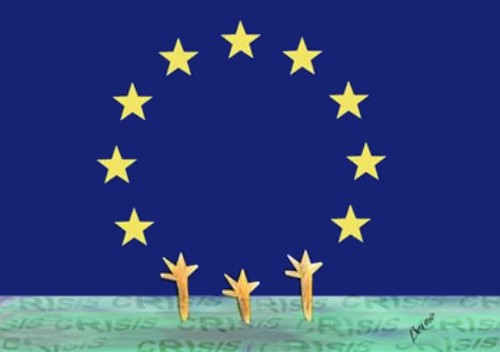 Pic.1 – Bernard Bouton/Bernie (FR)
Pic.1 – Bernard Bouton/Bernie (FR)
The crisis is represented by a flood; then, “submerged” European countries are represented by hands emerging from the water. As in the language of metaphor, a situation (the crisis) is compared to a real thing (the flood).
See the picture 2:
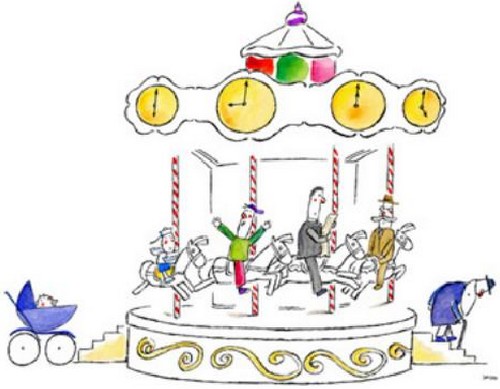 Pic. 2 – Diego Herrera/Yayo (CA/CO)
Pic. 2 – Diego Herrera/Yayo (CA/CO)
The human life is represented by a carousel; then, when you get out of the carousel, you are an old man.
See the picture 3:
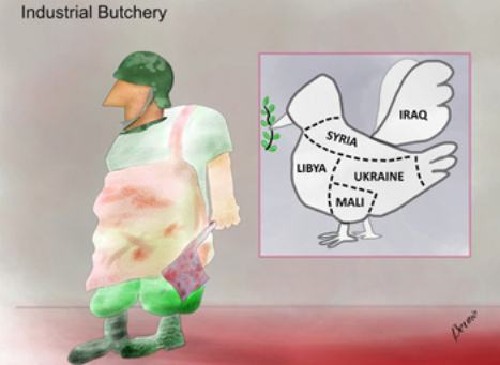 Pic. 3 – Bernard Bouton/Bernie (FR)
Pic. 3 – Bernard Bouton/Bernie (FR)
The soldier is represented by a butcher; then, the dove of peace is like pieces of meat.
In the classical language, a cliche is a dead metaphor. For example: America is a “melting pot”, some famous actress is a “shining star”. We can find cliches in cartooning too. See pictures 4 and 5
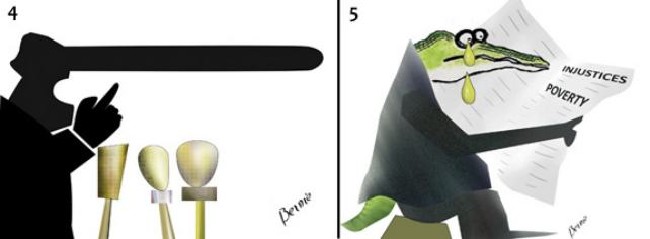 Pic. 4, 5 – Bernard Bouton/Bernie (FR)
Pic. 4, 5 – Bernard Bouton/Bernie (FR)
Metaphors very often use substitutions. For example, in the picture1 (above), three stars are being replaced by three hands. In the picture 3, the beef is being replaced by the dove. The cartoonists frequently use substitutions, mostly using with similar forms; but not all of them make metaphors.
Sometimes a substitution is used only to produce a surprise, to create a funny cartoon, just for a joke. See Pictures 6, 7, 8, 9, 10, 11
 Pic. 6 – Bernard Bouton/Bernie (FR), Pic. 7 – Elena Ospina (CO), Pic. 8 – Diego Herrera/Yayo (CA/CO)
Pic. 6 – Bernard Bouton/Bernie (FR), Pic. 7 – Elena Ospina (CO), Pic. 8 – Diego Herrera/Yayo (CA/CO)
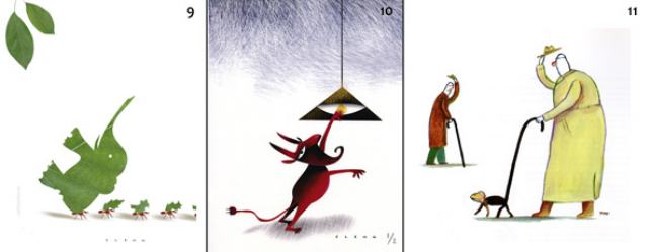 Pic. 9, 10 – Elena Ospina (CO) Pic. 11 – Diego Herrera/Yayo (CA/CO)
Pic. 9, 10 – Elena Ospina (CO) Pic. 11 – Diego Herrera/Yayo (CA/CO)
In an editorial cartoon a substitution is mostly used to send a message, for serving a cause or idea. See pictures 12, 13, 14, 15:
 Pic. 12 – Elena Ospina (CO) Pic. 15 – Bernard Bouton/Bernie (FR)
Pic. 12 – Elena Ospina (CO) Pic. 15 – Bernard Bouton/Bernie (FR)
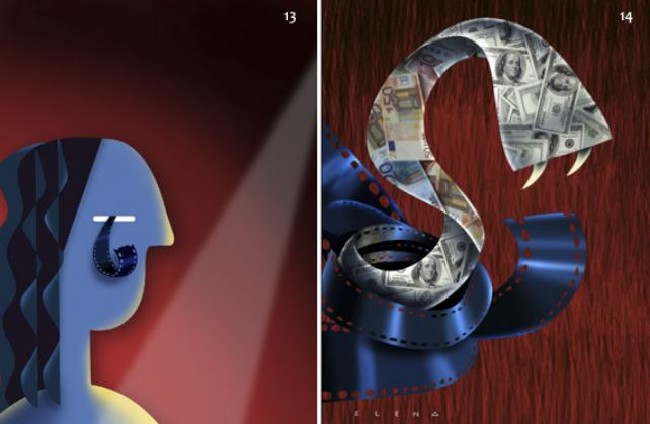 Pic. 13, 14 – Elena Ospina (CO)
Pic. 13, 14 – Elena Ospina (CO)
Picture 12: The fish bones are replaced by forks in order to suggest the scourge of famine in the world.
Picture 13: Tears are replaced by a roll of film; it suggests the exploitation of women in the film industry.
Picture 14: A roll of film is being replaced by a snake, itself been replaced by dollars, the meaning is the negative role of money in the world of cinema.
Picture 15: The DNA molecule is being replaced by prison bars, in order to denounce injustices often linked with skin colour.
The reader has to find the meaning of the substitution; it is like a game; there is a complicity between the cartoonist and the reader. But it is not always easy, as shown by the following example
Pictures 16, 17 and 18:
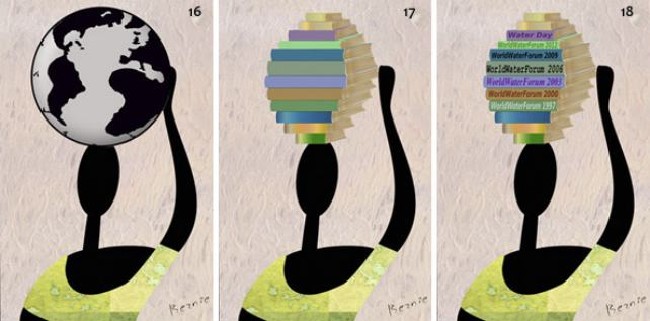 Pic. 16, 17, 18 – Bernard Bouton/Bernie (FR)
Pic. 16, 17, 18 – Bernard Bouton/Bernie (FR)
Picture 16: A jug is replaced by the Earth: usually, women are responsible for finding water, maybe that means women are in charge of the Earth (?)
Picture 17: The jug is replaced by a pile of books: does that mean that education is more important than housework?
Picture 18: The water jug is replaced by a pile of paper files linked with various water forums; ironically the cartoon suggests that a number of speeches have been given about the problem of the water, but things don’t change.
As noted above, a substitution does not always lead to a metaphor. So what is the way of recognizing whether or not there is a metaphor? Maybe it is possible to illustrate that through an example.
See the two pictures 19 and 20.
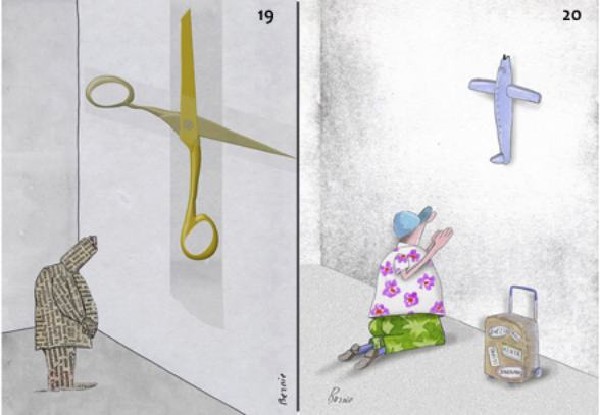 Pic. 19, 20 – Bernard Bouton/Bernie (FR)
Pic. 19, 20 – Bernard Bouton/Bernie (FR)
In both cases we have a substitution: in one picture the crucifix is replaced by a plane, in the other one by scissors. I think that only the picture 19 is a metaphor because we have a complete transposition of a situation from the world of press to a world made of concrete objects (the scissors symbolizing the censorship and sheets of newsprint symbolizing the press), the sheets of newsprint bowing before the cross/scissors, that’s like press bowing before the censorship.
“That’s like” is the leitmotiv of the metaphor; the carousel, that’s like our life; war, that’s like a butchery… and so on…
A metaphor is constructed logically. Of course, the borderline between a simple substitution and a metaphor is sometimes very blurred. Some artists use substitutions systematically ; most cartoonists use them in the preparation phase of their cartoons, in order to find an original idea. Then, the idea could become a metaphor or turn into another figure of speech we will talking about in a following article.
Bernard BOUTON (author is a renowned French cartoonist and theoretician of Cartoon art)
*****
